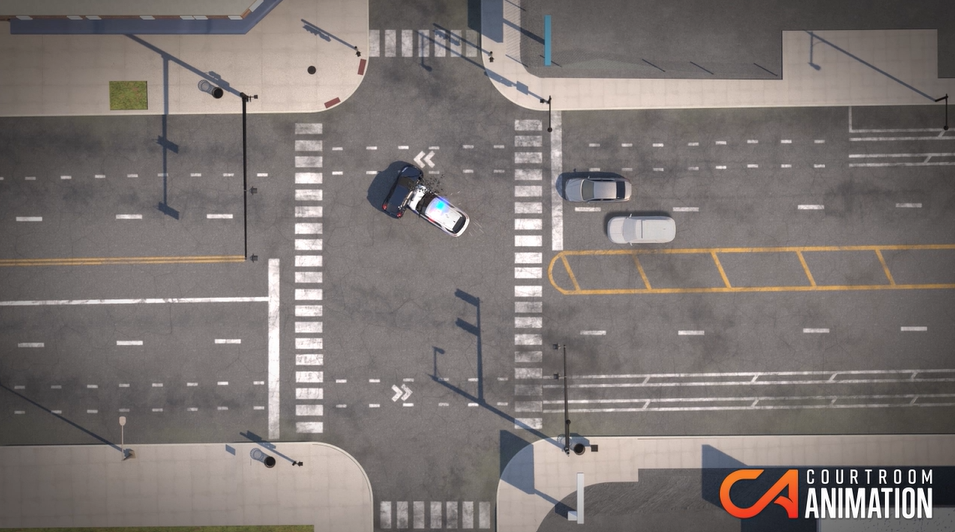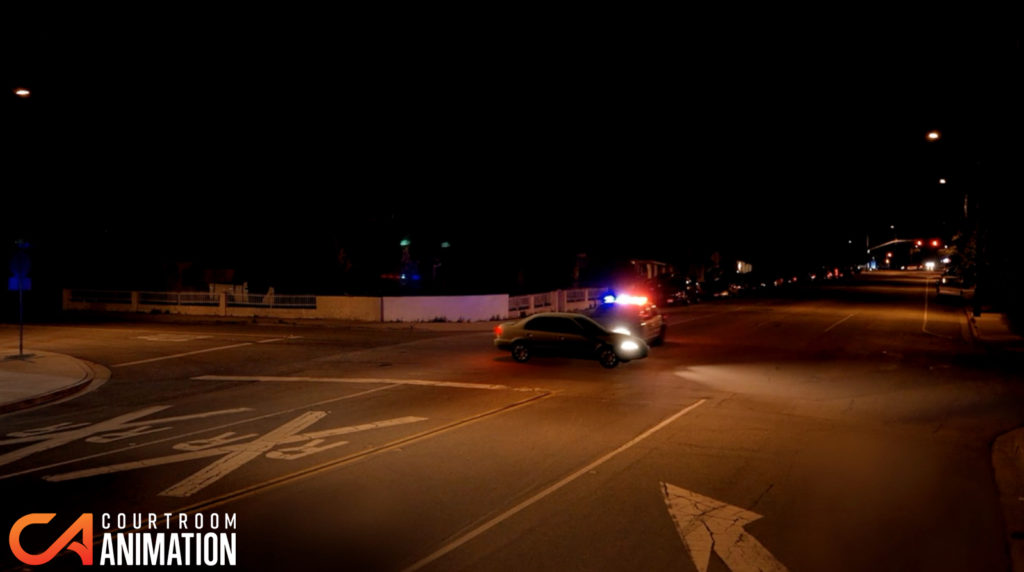Despite perceptions that trial demonstratives are primarily a tool for only one side, they are actually powerful tools for both plaintiff and defense attorneys. But how can either counsel leverage these types of trial exhibits and receive favorable verdicts? To answer that question, we highlight two case studies from the viewpoints of opposing counsels below. Both of these cases involved lawsuits against municipalities.
The first case involves a plaintiff attorney who landed an $8 million verdict from the jury. The second discusses how one defense counsel reached a favorable verdict after presenting a car crash animation.
Case #1: $8 Million Jury Verdict After Plaintiff Counsel Presented Trial Demonstratives
Summary:
A civilian was driving their Nissan through an intersection and had a green light. Based on the car’s positioning, the driver could not see around the corner of the street. As the Nissan driver entered the intersection, a police car collided with their vehicle at full speed. The plaintiff sustained major injuries from the collision.
After presenting the car crash animations, the jury determined that the defense was liable, and awarded an $8 million verdict.
Challenge:
Initially, the plaintiff counsel wanted to visualize a right-way wrong-way animation. It would depict how the police car was supposed to slow down at the intersection, as they had a red light. This is police protocol. However, to avoid any defense critiques of the visuals and to ensure they were admissible, our team featured only what had happened using physical data.
Without these trial demonstratives, the plaintiff counsel would have had a bigger challenge of explaining how the officer was violating protocol and negligent in their actions.
Solution: Admissible Trial Exhibits
These car crash animations helped the plaintiff counsel break down the incident frame by frame to the jury. By replaying or slowing the animations down for the jury at the right moments, the plaintiff attorney’s closing statements were that much more impactful.
The most important perspective was the trailing view of the Nissan to really visualize what the plaintiff could actually see, which did not include the police car’s lights.

Top View Still from Accident Reconstruction Animation
How were these trial demonstratives admissible? Our team recreated the scene using only physical data, i.e., surveillance camera footage, the police car’s black box data, and the expert assistance of an accident reconstructionist.
By using camera matching, which matches the camera’s viewpoint and perspective in a 3D world with the real world, our forensic animators validated the vehicles’ speeds, angles, and other data. This process ensured the accident reconstruction animations were admissible for trial.
Overall, these animations played a crucial part for the jury to understand the plaintiff’s point of view. Before deliberations, the jury had a clear picture in their mind of how the police officer broke protocol and should have slowed down at the intersection.
Results:
After reviewing the two motor vehicle collision animations, the jury determined that the defense counsel was liable for damages. The final decision was a verdict of $8 million to the plaintiff.
Case #2: Trial Demonstratives Help Land a Favorable Verdict for Defense Counsel
Summary:
In this case, a police officer had been responding to a complaint of a loud party at night, followed by a request for additional units. To do so, he had activated emergency procedures by turning on the vehicle’s lights that were flashing with maximum visibility.
The police officer drove at 57 miles per hour in the center of the road. A civilian moved forward from the stop sign into the middle of the intersection, which caused the police officer’s vehicle to collide with their vehicle. Unfortunately, two civilian passengers were killed in the broadside collision.
The plaintiffs sued the City of Fontana for the officer’s negligent actions, which they stated caused fatalities and injuries. The plaintiff’s were relatives of the civilians who perished. As all protocol had been followed, the jury determined that the defendant was not liable.
Challenge: Nighttime Visualizations
It was imperative that the jury was able to view a realistic depiction of the events, mainly the fully lit police cruiser entering the intersection. Without it, the defense counsel would have been at a disadvantage without a clear visual of the incident.
“The jury was rapt every time we played [the trial animation] in court and they asked to show it again while deliberating. After the verdict came down, many of the jurors told us that they really liked the video. It brought our case home!”
Lynberg & Watkins
After the collision, the officer exited his patrol car and noticed that the windows of the plaintiff’s vehicle were tinted. California law prohibits the application of dark tinting to the front windows of a vehicle. Showing the tinted windows, as well as visualizing the black box data, would have been a challenge without a car crash animation.
Solution:
The details of this nighttime accident recreation animation were crucial in expressing how the defendant was not liable for damages. It demonstrated the defense’s version of what occurred in the moments leading up to the collision in just 11 seconds.
To visualize to the jury how the police car’s lights were fully activated well before crossing the intersection, the animation used the unique approach of compositing a 3D model over actual video footage.

Legal Graphic from Car Crash Animation
This allowed our forensic animators to create a “drive-through” animation using a police cruiser at the scene of the accident, and then add the collision afterwards. It provided more strength to the defense’s accident reconstructionist testimony that it would have been impossible for the police officer to avoid colliding with the vehicle.
Using only physical data and the vehicle’s block box data ensured that the trial demonstratives were admissible in court. However, the plaintiff’s counsel did voice four objections:
- The recreation was not “conducted under substantially similar conditions as those of the actual occurrence,” rendering it irrelevant.
- The recreation will mislead the jury.
- The video usurps the role of the jury as a factfinder.
- The defendants had not allowed the plaintiffs to conduct discovery regarding “issues that could have fleshed out problems with the recreation.”
The defense countered that they had offered the plaintiff counsel opportunity to depose the creator of the animation, Courtroom Animation’s CEO Brady Held, but they had missed the deadline in discovery.
The trial court denied the plaintiffs’ objections. They concluded that the accident animation presented by the defendant was a fair and accurate representation of the evidence.
Results: Traffic Accident Animation Helped Land 100% Defense Verdict
The jury determined two special verdicts:
- The officer was responding to an emergency at the time of the collision.
- The officer was not negligent with respect to the collision.
While the plaintiff counsel had demanded $20 million, the jury determined a 100% favorable, but confidential, defense verdict.
Trial Demonstratives: Tools for Both Sides
As shown from the two cases above, trial exhibits are compelling tools for both plaintiff and defense attorneys. They helped the jury remember both attorneys’ arguments, understand the complex intricacies, and provided a visualization of physical data.
Want to learn more about how forensic animations can benefit both plaintiff and defense attorneys? Skim through our guide on forensic animation for legal cases for more info on car crash animations.